Pioneer GM-X642 User Manual [ru]

BRIDGEABLE POWER AMPLIFIER
AMPLIFICATEUR DE PUISSANCE PONTABLE
Owner’s Manual
GM-X642
Mode d’emploi
FRANÇAIS DEUTSCH ESPAÑOL ENGLISH
NEDERLANDS ITALIANO

Contents |
|
Before Using This Product ...................... |
2 |
In case of trouble .............................................. |
2 |
WARNING ........................................................ |
2 |
Setting the Unit .......................................... |
3 |
Gain Control ...................................................... |
3 |
Bass Boost Level Control .................................. |
3 |
Power Indicator ................................................ |
4 |
BFC (Beat Frequency Control) Switch ............ |
4 |
LPF (Low-Pass Filter)/HPF (High-Pass |
|
Filter) Select Switch .................................. |
4 |
Connecting the Unit .................................. |
5 |
Connection Diagram ........................................ |
6 |
Connecting the Power Terminal ........................ |
7 |
Connecting the Speaker Terminals .................. |
7 |
Connecting the Speaker wires .......................... |
8 |
Installation .................................................. |
9 |
Example of installation on the floor mat |
|
or on the chassis ........................................ |
9 |
Specifications .......................................... |
10 |
1

Before Using This Product
This product complies with the EMC Directives (89/336/EEC, 92/31/EEC) and CE Marking Directive (93/68/EEC).
Thank you for purchasing this PIONEER product. Before attempting operation, be sure to read this manual.
In case of trouble
When the unit does not operate properly, contact your dealer or the nearest authorized PIONEER Service Station.
WARNING
•Always use the special red battery and ground wire [RD-223], which is sold separately. Connect the battery wire directly to the car battery positive terminal (+) and the ground wire to the car body.
•Do not touch the amplifier with wet hands. Otherwise you may get an electric shock. Also, do not touch the amplifier when it is wet.
•For traffic safety and to maintain safe driving conditions, keep the volume low enough so that you can still hear normal traffic sound.
•Check the connections of the power supply and speakers if the fuse of the separately sold battery wire or the amplifier fuse blows. Detect the cause and solve the problem, then replace the fuse with another one of the same size and rating.
•To prevent malfunction of the amplifier and speakers, the protective circuit will cut the power supply to the amplifier (sound will stop) when an abnormal condition occurs. In such a case, switch the power to the system OFF and check the connection of the power supply and speakers. Detect the cause and solve the problem.
•Contact the dealer if you cannot detect the cause.
•To prevent an electric shock or short-circuit during connection and installation, be sure to disconnect the negative (–) terminal of the battery beforehand.
•Confirm that no parts are behind the panel when drilling a hole for installation of the amplifier. Be sure to protect all cables and important equipment such as fuel lines, brake lines and the electrical wiring from damage.
NEDERLANDS ITALIANO FRANÇAIS DEUTSCH ESPAÑOL ENGLISH
2
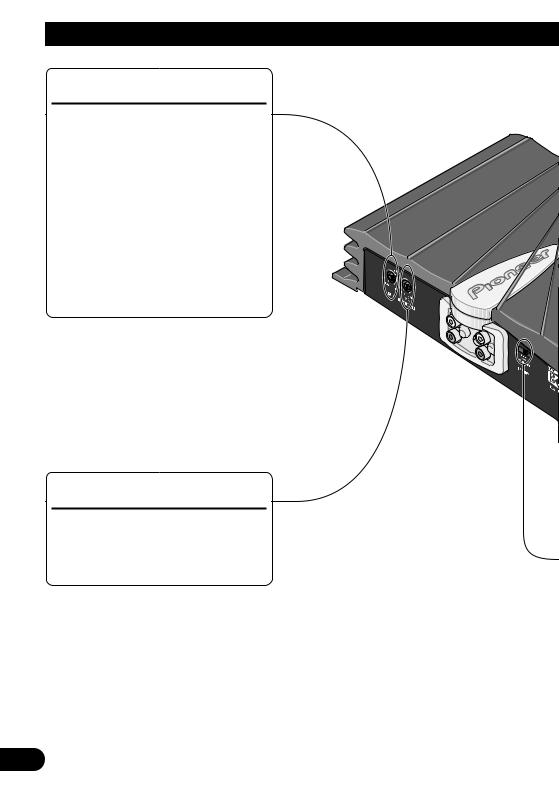
Setting the Unit
Gain Control
If the sound level is too low, even when the volume of the car stereo used along with this power amplifier is turned up, turn gain control on the front of the power amplifier clockwise. If the sound distorts when the volume is turned up, turn the gain control counter-clockwise.
•When using with an RCA equipped car stereo (standard output of 500 mV), set to the NORMAL position. When using with an RCA equipped Pioneer car stereo with max. output of 4 V or more, adjust level to match the car stereo output level.
•If you hear too much noise when using the speaker input terminals, turn the gain control counter-clockwise.
Bass Boost Level Control
Bass Boost Level Control can boost the level around 60 Hz from 0 to 18 dB.
•Bass Boost Level Control can be adjusted only when the LPF/HPF select switch is set to a position other than HPF.
3
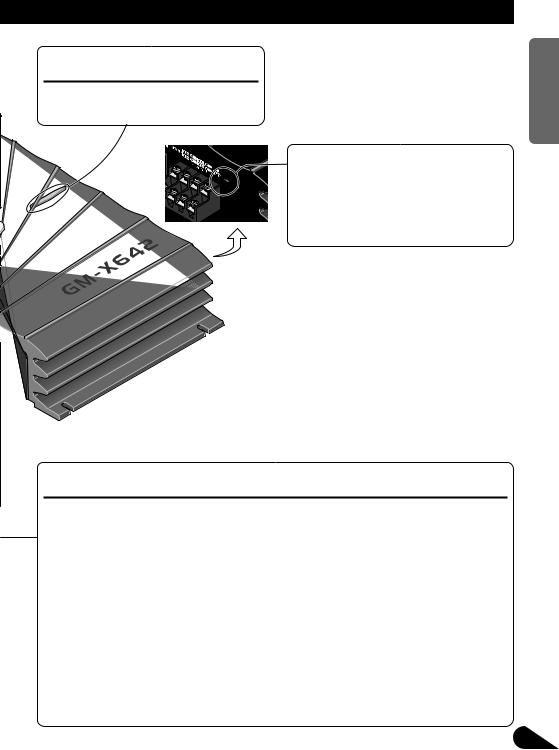
Power Indicator
The power indicator lights when the power is switched on.
BFC (Beat Frequency Control) Switch
If you hear a beat while listening to an MW/LW broadcast with your car stereo, change the BFC switch using a small standard tip screwdriver.
LPF (Low-Pass Filter)/HPF (High-Pass Filter) Select Switch
Set the LPF/HPF select switch as follows according to the type of speaker that is connected to the speaker output connector and the car stereo system:
LPF/HPF Select |
Audio frequency range |
Speaker |
Remarks |
Switch |
to be output |
Type |
|
LPF (left) |
Very Low Frequency range |
Subwoofer |
Connect a subwoofer. |
|
|
|
|
OFF (center) |
Full range |
Full range |
|
|
|
|
|
HPF (right) |
Low Frequency range to |
Full range |
Use if you want to cut the |
|
High Frequency range |
|
very low frequency range |
|
|
|
because it is not necessary |
|
|
|
for the speakers you are |
|
|
|
using. |
|
|
|
|
NEDERLANDS ITALIANO FRANÇAIS DEUTSCH ESPAÑOL ENGLISH
4
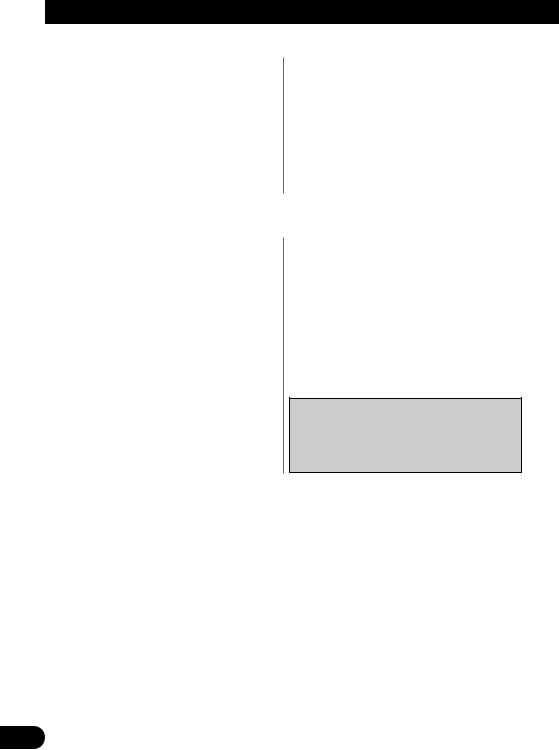
Connecting the Unit
CAUTION
•Disconnect the negative (–) terminal of the battery to avoid the risk of short-circuit and damage to the unit.
•Secure the wiring with cable clamps or adhesive tape. To protect the wiring, wrap adhesive tape around it where they lie against metal parts.
•Do not route wires where they will get hot, for example where the heater will blow over them. If the insulation heats up, it may become damaged, resulting in a short-circuit through the vehicle body.
To prevent damage
•Do not ground the speaker wire directly or connect a negative (–) lead wire for several speakers.
•This unit is for vehicles with a 12-volt battery and negative grounding. Before installing it in a recreational vehicle, truck or bus, check the battery voltage.
•If the car stereo is kept on for a long time while the engine is at rest or idling, the battery may go dead. Turn the car stereo off when the engine is at rest or idling.
•If the system remote control wire of the amplifier is connected to the power terminal through the ignition switch (12 V DC), the amplifier will always be on when the ignition is on— regardless of whether the car stereo is on or off. Because of this, the battery could go dead if the engine is at rest or idle.
•Make sure that wires will not interfere with moving parts of the vehicle, such as the gearshift, handbrake or seat sliding mechanism.
•Do not shorten any wires. Otherwise the protection circuit may fail to work when it should.
•Never feed power to other equipment by cutting the insulation of the power supply wire to tap from the wire. The current capacity of the wire will be exceeded, causing overheating.
•Speakers to be connected to the amplifier should conform with the standards listed below. If they do not conform, they may catch fire, emit smoke or become damaged. The speaker impedance must be 1 to 8 ohms for stereo connection, and 2 to 8 ohms for monaural and other bridge connection.
•Install and route the separately sold battery wire as far away as possible from the speaker wires. Install and route the separately sold battery wire, ground wire, speaker wires and the amplifier as far away as possible from the antenna, antenna cable and tuner.
•Cords for this product and those for other products may be different colors even if they have the same function. When connecting this product to another product, refer to the supplied Installation manuals of both products and connect cords that have the same function.
Speaker Channel |
Speaker Type |
Power |
|
Two-channel |
Subwoofer |
Nominal input: Min. 60 W |
|
|
|
||
Other than subwoofer |
Max. input: Min. 100 W |
||
|
|||
|
|
|
|
One-channel |
Subwoofer |
Nominal input: Min. 165 W |
|
|
|
||
Other than subwoofer |
Max. input: Min. 300 W |
||
|
|||
|
|
|
5
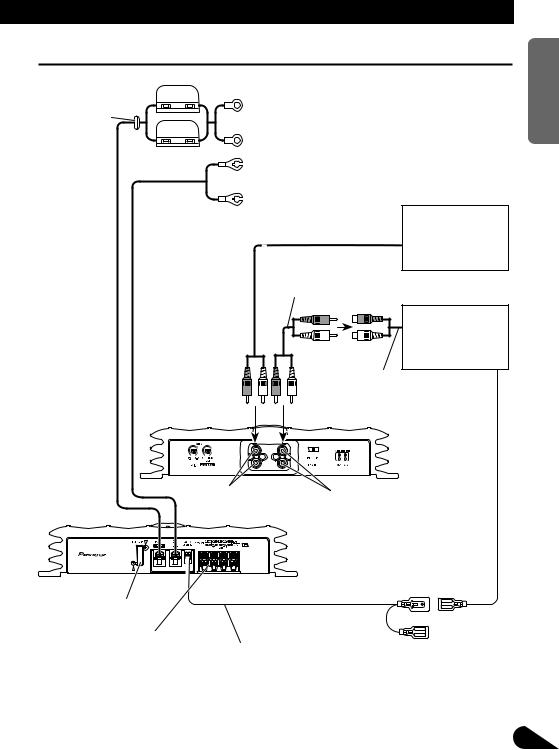
Connection Diagram
Fuse (30 A)
Special red battery wire [RD-223] (sold separately).
Grommet |
After making all other connections at the amplifier, |
|
|
||
|
connect the battery wire terminal of the amplifier to |
|
|
the positive (+) terminal of the battery. |
|
|
Fuse (30 A) |
|
|
Ground wire (black) [RD-223] (sold separately). |
|
|
Connect to metal body or chassis. |
|
|
RCA input |
Amplifier with |
|
RCA input jacks |
|
|
|
|
|
Connecting wires with RCA pin |
|
|
plugs (sold separately). |
|
|
|
Car stereo with |
|
|
RCA output jacks |
|
External Output |
|
|
Front side |
|
|
|
|
|
|
|
|
RCA output jack |
|
|
|
RCA input jack |
||
Back side
Fuse (25 A)
Speaker terminal.
See the “Connecting the Speaker wires” section for speaker connection instructions.
System remote control wire (sold separately)
Connect the male terminal of this wire to the system remote control terminal of the car stereo (SYSTEM REMOTE CONTROL). The female terminal can be connected to the auto-antenna relay control terminal. If the car stereo does not have a system remote control terminal, connect the male terminal to the power terminal through the ignition switch.
NEDERLANDS ITALIANO FRANÇAIS DEUTSCH ESPAÑOL ENGLISH
6

Connecting the Unit
Connecting the Power Terminal
•Always use the special red battery and ground wire [RD-223], which is sold separately. Connect the battery wire directly to the car battery positive terminal (+) and the ground wire to the car body.
1.Pass the battery wire from the engine compartment to the interior of the vehicle.
•After making all other connections to the amplifier, connect the battery wire terminal of the amplifier to the positive (+) terminal of the battery.
Fuse (30 A) Engine |
|
Interior of |
compart- |
the vehicle |
|
ment |
|
|
|
|
|
Fuse (30 A) |
Drill a 14 mm |
|
Positive terminal |
hole into the |
|
Insert the O-ring rubber |
vehicle body. |
|
|
|
|
grommet into the vehicle |
|
|
body. |
|
|
2.Twist the battery wire, ground wire and system remote control wire.
Twist
3.Attach lugs to wire ends. Lugs not supplied.
• Use pliers, etc., to crimp lugs to wires.
Lug
Ground wire
Lug
Battery wire
4.Connect the wires to the terminal.
•Fix the wires securely with the terminal screws.
|
GND terminal |
Power terminal |
System remote |
|
control terminal |
|
System remote |
|
control wire |
|
Ground wire |
Battery wire
Connecting the Speaker Terminals
1.Expose the end of the speaker wires by about 10 mm and twist using nippers or a cutter.
 Twist
Twist
10 mm
2.Attach lugs to speaker wire ends. Lugs not supplied.
• Use pliers, etc., to crimp lugs to wires.
Lug
Speaker wire
7
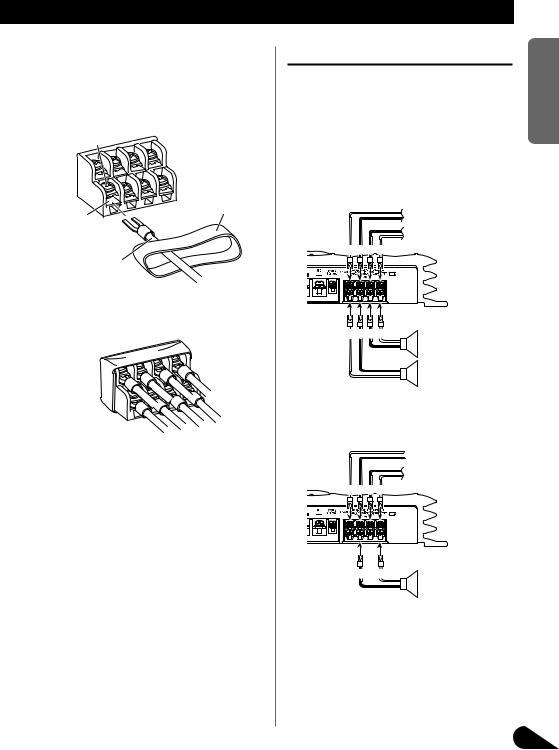
3.Connect the speaker wires to the speaker terminals.
•Connect the speaker wires, passing them through the terminal cover.
•Fix the speaker wires securely with the terminal screws.
Terminal screw
Terminal cover
Speaker terminal
Speaker wire
Connecting the Speaker wires
The speaker output mode can be twochannel (stereo) or one-channel (mono). Connect the speaker leads to suit the mode according to the figures shown below.
•When either the RCA input or the speaker input is connected, RCA output becomes functional. Do not connect both the RCA input and the speaker input at the same time.
Two-channel mode (stereo)
(Right) Speaker input (Left)

 +
+


 +
+
4. Push on the terminal cover.

 ++
++
(Left) Speaker (Right)
One-channel mode (mono)
 (Right) Speaker input (Left)
(Right) Speaker input (Left)

 +
+


 +
+
|
+ |
Speaker |
|
|
|
|
|
(Mono) |
NEDERLANDS ITALIANO FRANÇAIS DEUTSCH ESPAÑOL ENGLISH
8
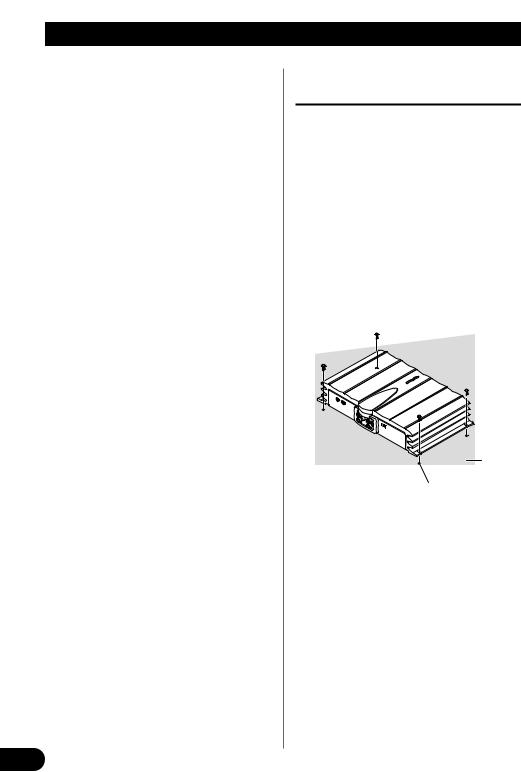
Installation
CAUTION
•Do not install in:
—Places where it could injure the driver or passengers if the vehicle stops suddenly.
—Places where it may interfere with the driver, such as on the floor in front of the driver’s seat.
•Make sure that wires are not caught in the sliding mechanism of the seats, resulting in a short-cir- cuit.
•Confirm that no parts are behind the panel when drilling a hole for installation of the amplifier. Protect all cables and important equipment such as fuel lines, brake lines and electrical wiring from damage.
•Install tapping screws in such a way that the screw tip does not touch any wire. This is important to prevent wires from being cut by vibration of the car, which can result in fire.
•To prevent electric shock, do not install the amplifier in places where it might come in contact with liquids.
•To ensure proper installation, use the supplied parts in the manner specified. If any parts other than the supplied ones are used, they may damage internal parts of the amplifier, or they may become loose causing the amplifier to shut down.
To prevent malfunction
•To ensure proper heat dissipation of the amplifier, be sure of the following during installation.
—Allow adequate space above the amplifier for proper ventilation.
—Do not cover the amplifier with a floor mat or carpet.
•Do not install the amplifier near a door where it may get wet.
•Do not install the amplifier on unstable places such as the spare tire board.
•The best location for installation differs with the car model and installation location. Secure the amplifier at a sufficiently rigid location.
•Make temporary connections first and check that the amplifier and the system operate properly.
•After installing the amplifier, confirm that the spare tire, jack and tools can be easily removed.
Example of installation on the floor mat or on the chassis
1.Place the amplifier where it is to be
installed. Insert the supplied tapping screws (4 × 18 mm) into the
screw holes. Push on the screws with a screwdriver so they make marks where the installation holes are to be located.
2.Drill 2.5 mm diameter holes at the point marked, and install the amplifier, either on the carpet or directly to the chassis.
Tapping-screws
 (4 × 18 mm)
(4 × 18 mm)
Floor mat or chassis
Drill a 2.5 mm diameter hole
9

Specifications
Power source .......................................................................................................... |
14.4 V DC (10.8 — 15.1 V allowable) |
Grounding system .......................................................................................................................................... |
Negative type |
Current consumption .................................................................................................... |
15.5 A (at continuous power, 4 Ω) |
Average current drawn* ........................................................................................................ |
5.6 A (4 Ω for two channels) |
|
8.8 A (4 Ω for one channel) |
Fuse .............................................................................................................................................................................. |
25 A |
Dimensions ...................................................................................................................... |
270 (W) × 60 (H) × 165 (D) mm |
Weight .................................................................................................................... |
2.7 kg (Leads for wiring not included) |
Maximum power output .................................................................................................................. |
100 W × 2 / 300 W × 1 |
Continuous power output ........................................................................ |
75 W × 2 / 195 W × 1 (DIN45324, +B=14.4 V) |
Load impedance .......................................................................................................................... |
4 Ω (1 — 8 Ω allowable) |
|
(Bridge connection: 2 — 8 Ω allowable) |
Frequency response .......................................................................................................... |
10 — 50,000 Hz (+0 dB, –1 dB) |
Signal-to-noise ratio .................................................................................................................... |
105 dB (IEC-A network) |
Distortion ........................................................................................................................................ |
0.005 % (10 W, 1 kHz) |
Separation ...................................................................................................................................................... |
65 dB (1 kHz) |
Low pass filter .............................................................................................................................. |
Cut off frequency: 80 Hz |
|
Cut off slope: –12 dB/oct |
High pass filter .......................................................................................................................... |
Cut off frequency: 80 Hz |
|
Cut off slope: –12 dB/oct |
Bass boost ................................................................................................................................................ |
Frequency: 60 Hz |
|
Gain: 0 — 18 dB |
Maximum input level/impedance .................................................................................. |
RCA: 6.5 V/22 kΩ (0.4 — 6.5 V) |
|
Speaker: 26 V/40 kΩ (1.6 — 26 V) |
Note:
•Specifications and the design are subject to possible modification without notice due to improvements.
*Average current drawn
•The average current drawn is nearly the maximum current drawn by this unit when an audio signal is input. Use this value when working out total current drawn by multiple power amplifiers.
NEDERLANDS ITALIANO FRANÇAIS DEUTSCH ESPAÑOL ENGLISH
10

Contenido |
|
Antes de usar este producto .................... |
2 |
En caso de desperfectos .................................... |
2 |
ADVERTENCIA .............................................. |
2 |
Ajuste de esta unidad .............................. |
3 |
Control de ganancia .......................................... |
3 |
Control del nivel de refuerzo de graves .................... |
3 |
Indicador de alimentación ................................ |
4 |
Interruptor BFC |
|
(Control de la frecuencia de batido) .......... |
4 |
Interruptor de selección LPF (Filtro de paso |
|
bajo)/HPF (Filtro de paso alto) .................. |
4 |
Conexión de la unidad .............................. |
5 |
Diagrama de conexión ...................................... |
6 |
Conexión del terminal de alimentación ............ |
7 |
Conexión del terminal de altavoz ...................... |
7 |
Conexión de los cables de altavoces ................ |
8 |
Instalación .................................................. |
9 |
Ejemplo de instalación en la alfombra |
|
del piso o en el chasis ................................ |
9 |
Especificaciones .................................... |
10 |
1

Antes de usar este producto
Este producto cumple con las Directivas EMC (89/336/CEE, 92/31/CEE) y Directiva de Marcación CE (93/68/CEE).
Muchas gracias por la adquisición de este producto PIONEER. Antes de tratar de operarlo, lea atentamente este manual.
En caso de desperfectos
Si esta unidad no funciona correctamente, póngase en contacto con su distribuidor o con el Centro de Servicio PIONEER autorizado más cercano.
ADVERTENCIA
•Siempre utilice el cable de batería rojo especial y el cable de tierra [RD-223], vendidos separadamente. Conecte el cable de batería directamente al terminal positivo de la batería del vehículo (+) y el cable de tierra a la carrocería del vehículo.
•No toque en el amplificador con las manos mojadas. Caso contrario, usted puede llevar un choque eléctrico. Igualmente, no toque en el amplificador cuando esté mojado.
•Para seguridad del tráfico y para mantener condiciones de conducción seguras, mantenga el volu - men suficientemente bajo de manera que aun se pueda escuchar el sonido del tráfico normal.
•Verifique las conexiones del suministro de energía y altavoces para ver si el fusible del cable de batería vendido separadamente o el fusible del amplificador se queman. Detecte la causa y solucione el problema, y reemplace el fusible con un otro del mismo tamaño y régimen.
•Para evitar mal funcionamiento del amplificador y altavoces, el circuito de protección cortará la alimentación al amplificador (el sonido se detendrá) cuando se produzca una situación anor - mal. En tal caso, apague el sistema y verifique la conexión de la alimentación y altavoces. Detecte la causa y resuelva el problema.
•Contacte a su distribuidor si no puede detectar la causa.
•Para evitar choques eléctricos o cortocircuitors durante la conexión e instalación, asegúrese de desconectar el terminal negativo (–) de la batería antes de proceder.
•Confirme que ninguna parte quede detrás del panel, cuando perfore un orificio para la instalación del amplificador. Asegúrese de proteger todos los cables y equipos importantes, tales como líneas de combustibles, líneas de frenos y el cableado eléctrico.
NEDERLANDS ITALIANO FRANÇAIS DEUTSCH ESPAÑOL ENGLISH
2
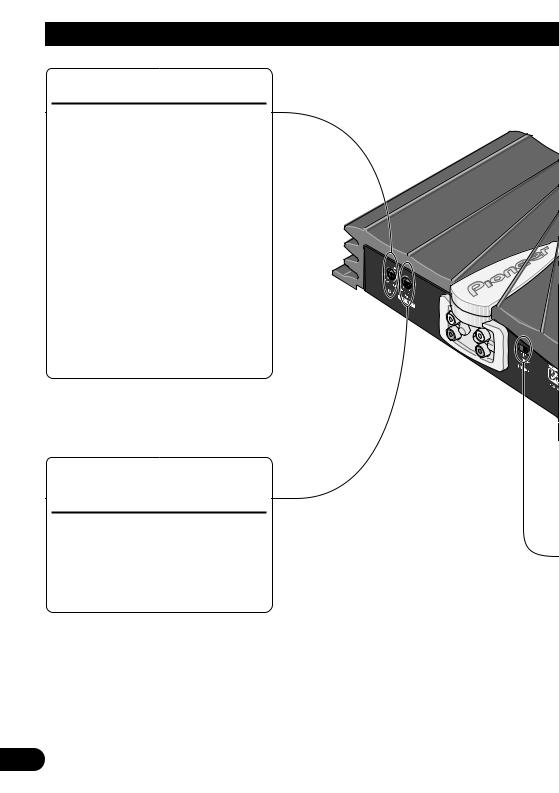
Ajuste de esta unidad
Control de ganancia
Si el nivel del sonido está muy bajo, aún cuando se aumenta el volumen del equipo estéreo para automóvil usado con este amplificador de potencia, gire a la izquierda el control de ganancia en la parte delantera del amplificador de potencia. Si hay distorsión del sonido cuando se aumenta el volumen del equipo estéreo de automóvil, gire los controles a la izquierda.
•Cuando se usa un estéreo de automóvil equipado con RCA (salida estándar de 500 mV), ajuste a la posición normal.
Cuando use con un estéreo de automóvil Pioneer equipado con RCA con una salida máxima de 4 V o más, ajuste el nivel para adecuarse al nivel de salida del estéreo del automóvil.
•Si se oye ruido excesivo cuando se usan los terminales de entrada de altavoz, gire el control de nivel a la izquierda.
Control del nivel de refuerzo de graves
El control del nivel de refuerzo de graves puede reforzar el nivel alrededor de 60 Hz de 0 a 18 dB.
•El control del nivel de refuerzo de graves se puede ajustar solamente cuando el interruptor de selección LPF/HPF está en una posición diferente de HPF.
3
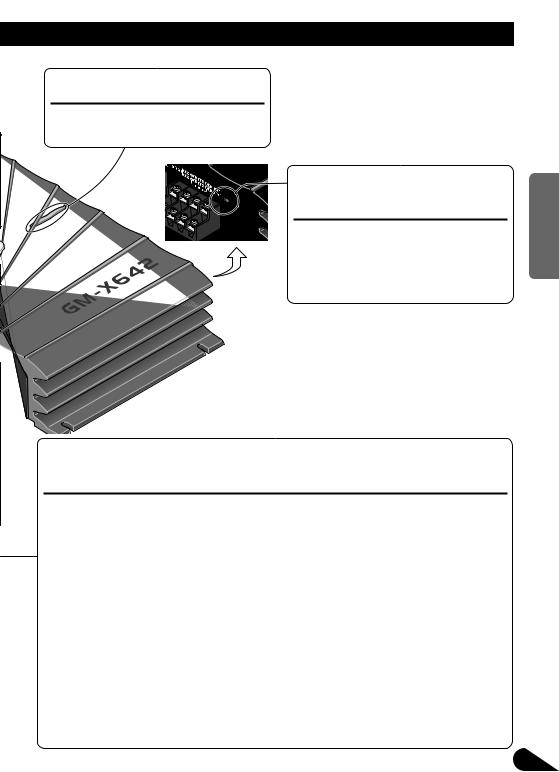
Indicador de alimentación
El indicador de alimentación se ilumina cuando la unidad se encuentra activada.
Interruptor BFC (Control de la frecuencia de batido)
Si escucha sonidos de batido mientras está recibiendo una emisora de MW/LW con su estéreo de automóvil, cambie el interruptor BFC usando un destornillador pequeño.
Interruptor de selección LPF (Filtro de paso bajo)/HPF (Filtro de paso alto)
Ajuste el interruptor de selección LPF/HPF de la manera siguiente, de acuerdo al tipo de altavoz que se encuentra conectado al conector de salida de altavoz y al sistema estéreo de automóvil:
Interruptor de |
Gama de frecuencia |
Tipo de |
Observaciones |
selección LPF/HPF |
de audio a ser generada |
altavoz |
|
LPF (izquierda) |
Gama de frecuencia |
Altavoz de |
Conecte a un altavoz de |
|
muy baja |
graves |
graves secundario. |
|
|
secundario |
|
|
|
|
|
OFF (central) |
Gama completa |
Gama completa |
|
|
|
|
|
HPF (derecha) |
Gama de frecuencia |
Gama completa |
Utilice si desea cortar la |
|
baja a gama de |
|
gama de frecuencia muy |
|
frecuencia alta |
|
baja debido a que no es |
|
|
|
necesaria para el altavoz |
|
|
|
que está usando. |
|
|
|
|
NEDERLANDS ITALIANO FRANÇAIS DEUTSCH ESPAÑOL ENGLISH
4
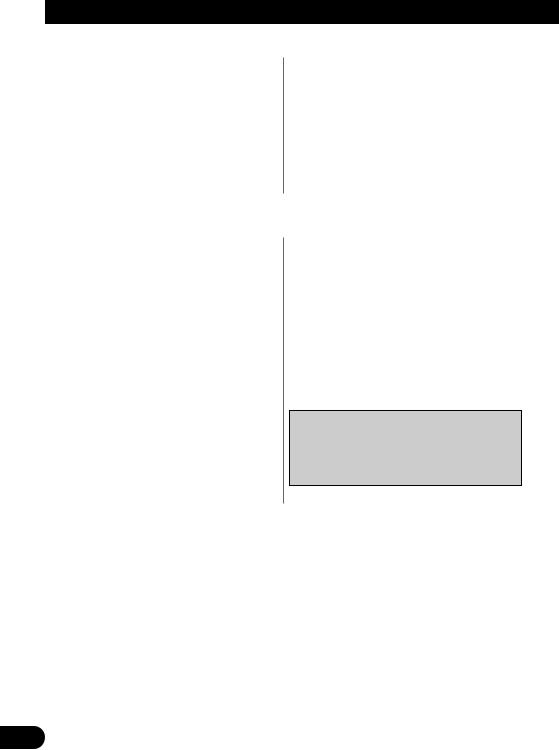
Conexión de la unidad
PRECAUCION
•Quite el terminal negativo (–) de la batería para evitar riesgo de cortocircuitos y daño a la unidad.
•Asegure el alambrado con abrazaderas de cable o cinta adhesiva. Para proteger el alambrado, envuelva cinta adhesiva alrededor de ellos en donde contacta con partes metálicas.
•No tienda cables por donde puedan calentarse, por ejemplo donde el calentador sople sobre ellos. Si la aislación se calienta, podría resultar dañada, resultando en cortocircuito a través de la carrocería del vehículo.
•Asegúrese que los alambres no interfieran con partes móviles del vehículo como la palanca de cambios, el freno de mano o el mecanismo de deslizamiento de los asientos.
•No corte ningún cable. De otra manera, el circuito de protección podría no funcionar cuando debiera.
•Nunca alimente otro equipo cortando la aislación del cable de alimentación y conectándolo al cable. La capacidad de corriente del cable será excedida, causando sobrecalentamiento.
Para prevenir de daños
•No conecte a tierra (masa) el cable del altavoz directamente ni conecte un cable negativo (–) a varios altavoces.
•Esta unidad es para vehículos con una batería de 12 voltios y terminal negativo a tierra. Antes de instalar en un vehículo de recreación, camión u ómnibus, verifique el voltaje de la batería.
•Si el sistema estereofónico del coche está funcio - nando por un largo período de tiempo mientras el motor permanece inactivo o en marcha al ralentí, la batería puede agotarse. Apague el estéreo de automóvil cuando el motor se encuentre funcio - nando en marcha al ralenté o permanece in activo.
•Si el cable del control remoto del sistema del amplificador se conecta al terminal de alimentación a través del interruptor de encendido (12 V de CC), el amplificador estará siempre activado cuando el encendido está activado, sin considerar de si el estéreo de automóvil se encuentra activado o desactivado. Debido a esto, la batería puede agotarse si deja el motor funcionando en marcha al ralentí o permanece inactivo.
•Los altavoces a ser conectados al amplificador deben estar conforme con las normas listadas debajo. Si no cumplen con las normas, pueden combustionar, emitir humos o dañarse. La imped - ancia del altavoz debe ser de 1 a 8 ohmios para conexiones estéreo, y de 2 a 8 ohmios para conex - iones monaurales y acoplamientos en derivación.
•Instale y coloque el cable de batería vendido separadamente lo más alejado posible de los cables de los altavoces. Instale y coloque el cable de batería y cable de tierra vendidos separadamente, los cables de los altavoces, y el amplificador lo más alejados posible de la antena, cable de antena y sintonizador.
•Los cables para esta unidad y aquéllas para las unidades pueden ser de colores diferentes aun si tienen la misma función. Cuando se conecta esta unidad a otra, refiérase a los manuales de instalación de ambas unidades y conecte los cables que tienen la misma función.
Canal de altavoces Tipo de altavoz |
Alimentación |
||
Dos canales |
Altavoz de graves secundario |
Entrada nominal: 60 W mín. |
|
|
|
||
Diferente a un altavoz de graves secundario |
Entrada máxima: 100 W mín. |
||
|
|||
|
|
|
|
Uno canal |
Altavoz de graves secundario |
Entrada nominal: 165 W mín. |
|
|
|
||
Diferente a un altavoz de graves secundario |
Entrada máxima: 300 W mín. |
||
|
|||
|
|
|
|
5
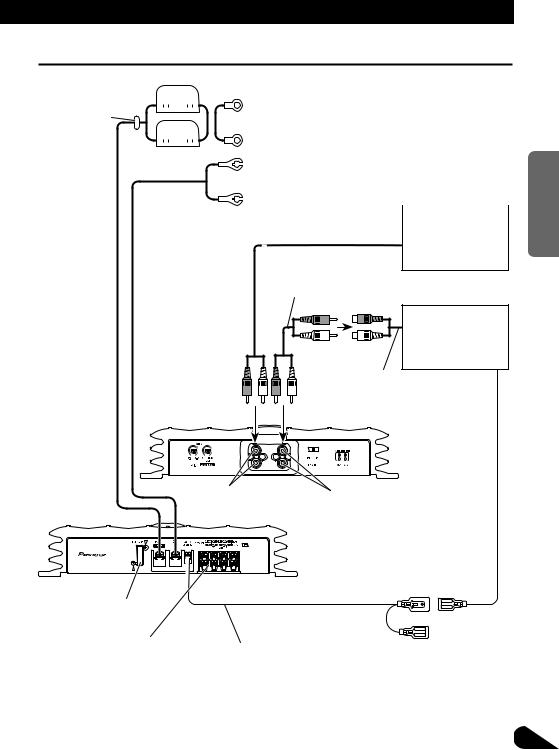
Diagrama de conexión
|
Fusible (30 A) |
|
||||||||||||||||
|
|
|
|
|
|
|
|
|
|
|
|
|
|
|
|
Cable de batería rojo especial [RD-223] |
||
Ojal |
|
|
|
|
|
|
|
|
|
|
|
|
|
|
|
(en venta por separado). |
|
|
|
|
|
|
|
|
|
|
|
|
|
|
|
|
|
|
Después de realizar todas las conexiones al amplificador, |
||
|
|
|
|
|
|
|
|
|
|
|
|
|
|
|||||
|
|
|
|
|
|
|
|
|
|
|
|
|
|
|
|
conecte el terminal del conductor de batería del amplificador |
||
|
|
|
|
|
|
|
|
|
|
|
|
|||||||
|
|
|
|
|
|
|
|
|
|
|
|
|
|
|
|
al terminal positivo (+) de la batería. |
|
|
|
Fusible (30 A) |
|
||||||||||||||||
|
|
|
|
|
|
|
|
|
|
|
|
|
|
|
|
Cable de puesta a tierra (negro) [RD-223] |
||
|
|
|
|
|
|
|
|
|
|
|
|
|
|
|
|
(en venta por separado). |
|
|
|
|
|
|
|
|
|
|
|
|
|
|
|
|
|
|
Conecte a una carrocería metálica o chasis. |
||
|
|
|
|
|
|
|
|
|
|
|
|
|
|
|
|
|
|
|
|
|
|
|
|
|
|
|
|
|
|
|
|
|
|
|
Entrada RCA |
Amplificador con |
|
|
|
|
|
|
|
|
|
|
|
|
|
|
|
|
|
tomas con conector |
||
|
|
|
|
|
|
|
|
|
|
|
|
|
|
|
|
|
|
|
|
|
|
|
|
|
|
|
|
|
|
|
|
|
|
|
|
|
de entrada RCA |
Conexión de cables con los enchufes de conector RCA (en venta por separado).
Estéreo de automóvil con tomas con conector de salida RCA
Salida externa
Lado delantero
|
|
|
|
|
|
|
|
|
Tomas de conector |
Tomas de conector de entrada RCA |
|||||||||||||||
|
|
|
|
|
|
|
|
|
de salida RCA |
||||||||||||||||
|
|
|
|
|
|
|
|
|
|
||||||||||||||||
|
|
|
|
|
|
|
|
|
|
|
|
|
|
|
|
|
|
|
|
|
|
|
|
|
|
|
|
|
|
|
|
|
|
|
|
|
|
|
|
|
|
|
|
|
|
|
|
|
|
|
|
|
|
|
|
|
|
|
|
|
|
|
|
|
|
|
|
|
|
|
|
|
|
|
|
|
|
|
|
|
|
|
|
|
|
|
|
|
|
|
|
|
|
|
|
|
|
|
|
|
|
|
|
|
|
|
|
|
|
|
|
|
|
|
|
|
|
|
|
|
|
|
|
|
|
|
|
|
|
Fusible (25 A)
Terminal de altavoz. Vea la sección “Conexión
de los cables de altavoces” para las instrucciones de conexión del altavoz.
Lado trasero
Cable del control remoto del sistema (en venta por separado) Conecte el terminal macho de este hilo al terminal de control remoto de sistema del equipo estéreo para automóvil (SYSTEM REMOTE CONTROL). El terminal hembra puede ser conectado al terminal de control del relé de antena. Si el estéreo de automóvil no tiene un terminal de control remoto del sistema, conecte el terminal macho al terminal de alimentación a través del interruptor de encendido.
NEDERLANDS ITALIANO FRANÇAIS DEUTSCH ESPAÑOL ENGLISH
6
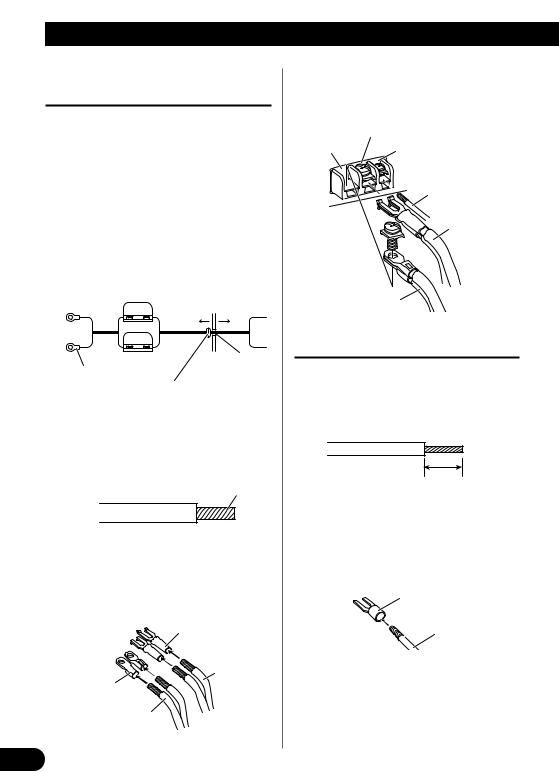
Conexión de la unidad
Conexión del terminal de alimentación
•Siempre utilice el cable de batería rojo especial y el cable de tierra [RD-223], vendidos separadamente. Conecte el cable de batería directamente al terminal positivo de la batería del vehículo (+) y el cable de tierra a la carrocería del vehículo.
1.Pase el cable de batería desde el compartimiento del motor al interior del vehículo.
•Luego de hacer todas las otras conexiones al amplificador, conecte el terminal del conductor de batería del amplificador al terminal positivo (+) de la bateria.
Fusible (30 A) |
Comparti- |
|
|
miento del |
Interior del |
||
|
motor |
|
vehículo |
Fusible (30 A) |
|
Perfore un orifi- |
|
Terminal positivo |
|
cio de 14 mm en |
|
Inserte el ojal de caucho |
la carrocería del |
||
|
|
||
de la junta tórica en la |
vehículo. |
|
|
corrocería del vehículo. |
|
2.Tuerza el cable de batería, cable de puesta a tierra y cable de control remoto del sistema.
Tuérzala
3.Fije las orejetas a los extremos de los cables. Orejetas no suministrados.
•Utilice alicates, etc. para plegar las orejetas a los cables.
Orejeta
Cable de puesta a tierra
Orejeta
Cable de batería
4.Conecte los cables al terminal.
•Fijar los cables firmemente utilizando los tornillos para terminales.
Terminal |
Terminal GND |
|
|
POWER |
Terminal de control |
|
remoto del sistema |
|
Cable del control |
|
remoto del sistema |
|
Cable de puesta |
|
a tierra |
Cable de batería
Conexión del terminal de altavoz
1.Desnude la extremidad de los cables de altavoces por aproximadamente 10 mm y tuérzala utilizando alicates o una tajadera.
 Tuérzala
Tuérzala
10 mm
2.Fije las orejetas a los extremos de los cables de altavoz. Orejetas no suministrados.
•Utilice alicates, etc. para plegar las orejetas a los cables.
Orejeta
Cable de altavoz
7
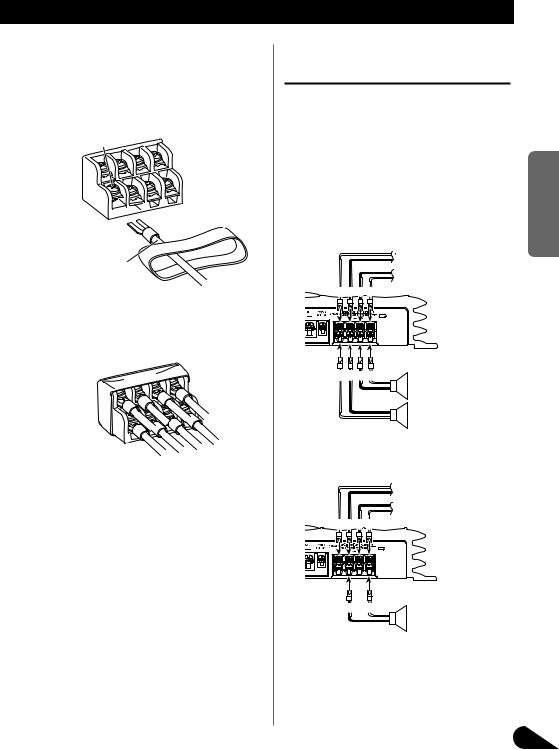
3.Conecte los cables de altavoz al terminal de altavoz.
•Conecte los hilos de altavoz, pasándolos a través de la cubierta de los terminales.
•Fije los cables firmemente utilizando los tornillos para terminales.
Torrillo de terminal
Cubierta de los


 terminales Terminal de
terminales Terminal de 

altavoz
Cable de altavoz
4.Empuje la cubierta de los terminales.
Conexión de los cables de altavoces
El modo de salida de altavoces puede ser en dos canales (estéreo) o uno canal (mono). Conecte los cables de altavoz para ajustarse al modo según los diagramas mostrados abajo.
•Cuando la entrada de RCA o la entrada de altavoz está conectada, la salida de RCA viene funcionada. No poder conectar tanto la entrada de RCA y la entrada de altavoz al mismo tiempo.
Modo de dos canales (estéreo)
(Derecho)
Entrada del altavoz (Izquierdo)

 +
+


 +
+

 ++
++
(Izquierdo) Altavoz (Derecho)
Modo de uno canal (mono)
|
(Derecho) |
|
Entrada del altavoz |
++ |
(Izquierdo) |
|
+
Altavoz (Mono)
NEDERLANDS ITALIANO FRANÇAIS DEUTSCH ESPAÑOL ENGLISH
8
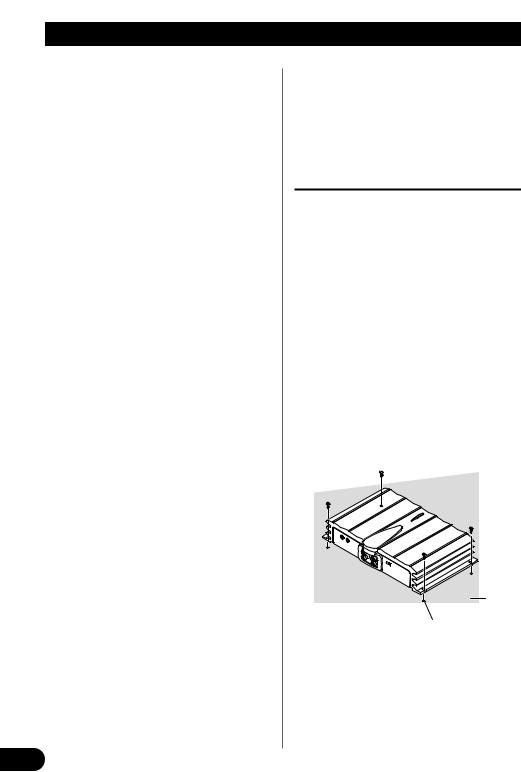
Instalación
PRECAUCION
•No lo instale en:
—Donde podría lesionar al conductor o a los pasajeros si se detiene el vehículo bruscamente.
—Donde podría interferir con el conductor, como por ejemplo en el piso en frente al asiento del conductor.
•Asegúrese que los cables no se enganchen en el mecanismo deslizante de los asientos, resultando en cortocircuito.
•Confirme que ninguna parte quede detrás del panel, cuando perfore un orificio para la instalación del amplificador. Asegúrese de proteger todos los cables y equipos importantes, tales como líneas de combustibles, líneas de frenos y el cableado eléctrico.
•Instale los tornillos de conexión de manera tal que la punta del tornillo no toque ningún cable. Esto es importante para evitar que los cables se corten por vibración del automóvil, lo que podría causar un incendio.
•Para evitar choques eléctricos, no instale el amplificador en donde pueda entrar en contacto con líquidos.
•Para asegurar una instalación apropiada, utilice las partes suministradas de la manera especificada. Si se utiliza cualquier otra parte que no sean las suministradas, puede dañarse las partes internas del amplificador, o pueden aflojarse y el amplificador puede dejar de funcionar.
Para evitar fallas del funcionamiento
•Para asegurar la disipación de calor apropriada del amplificador, cuide de lo siguiente durante la instalación.
—Permita un espacio adecuado en la parte superior del amplificador para una ventilación apropiada.
—No cubra el amplificador con la cubierta de piso o alfombra.
•No instale el amplificador cerca de una puerta en donde puede ser mojado por la lluvia.
•No instale el amplificador sobre superficies inestables como el tablero del neumático de repuesto.
•Confirme que ninguna parte quede detrás del panel, cuando perfore un orificio para la instalación del amplificador. Asegúrese de proteger todos los cables y equipos importantes, tales como líneas de combustibles, líneas de frenos y el cableado eléctrico.
•Realice primero conexiones provisorias y compruebe que el amplificador y el sistema operan adecuadamente.
•Para asegurar una instalación apropiada, utilice las partes suministradas de la manera especificada. Si se utiliza cualquier otra parte que no sean las suministradas, puede dañarse las partes internas del amplificador, o pueden aflojarse y el amplificador puede dejar de funcionar.
Ejemplo de instalación en la alfombra del piso o en el chasis
1.Ubique el amplificador en la posición en donde va a ser instalado.
Inserte los tornillos autoterrajantes suministrados (4 × 18 mm) en los
orificios de los tornillos. Presione los tornillos con un destornillador de modo que puedan dejar puntos marcados de la posición en donde irán los orificios para la instalación.
2.Perfore orificios de 2,5 mm de diámetro en el punto marcado, e instale el amplificador, ya sea en la alfombra o directamente en el chasis.
Tornillos autoterrajantes
 (4 × 18 mm)
(4 × 18 mm)
Alfombra del piso o chasis
Perfore un orificio de 2,5 mm de diámetro
9
